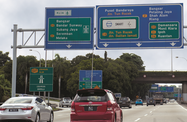Some important changes for the Malaysian aviation sector lie ahead, after the recent announcement by the main shareholders of the country’s two major airlines that they are beginning a new partnership.
The two carriers – Malaysia Airlines (MAS) and Air Asia – have long been fierce rivals, competing on routes and prices both domestically and internationally. On August 9 though, Tune Air, Air Asia’s parent, and the government’s Khazanah Nasional, which owns 69.5% of MAS, agreed to a share swap. Under this, Khazanah takes up 10% of Air Asia, while Tune takes up 20.5% of MAS.
The deal is based on the closing prices of RM1.60 ($0.53) for MAS shares and RM3.95 ($1.31) for Air Asia shares, as of Friday, August 5. Each airlines’ existing shareholders are also being given a free warrant, under which MAS shareholders get one free Air Asia warrant for every 30 MAS shares held, while Air Asia shareholders get one free MAS warrant for every 10 Air Asia shares held.
The arrangement keeps the two airlines as separate entities, with their own profit and loss accounts, as well as their own shares. There is also no alteration in the majority ownership position – Khazanah remains the largest shareholder in MAS, with a 49% stake, while Tune remains the largest single share owner in Air Asia, with 23%. Thus the term “partnership” rather than “take over” has been attached to the deal. Most see it as an arrangement likely to help MAS address some of its current balance sheet challenges, while also benefitting Air Asia by reducing risk and increasing synergies.
For the latter point, the role model most often cited is the KLM-Air France partnership. In its report on the deal, Maybank Investment Bank (Maybank IB) said that the “KLM-Air France Group has become stronger, more efficient and significantly more profitable” following its arrangement, with the airlines maintaining their identity (both are also national flag carriers). The two also saved as much as $864.4m in 2009 alone, thanks to their strategic partnership, according to Maybank IB.
The largest slice of these savings comes from fare alignment – and thus an end to predatory price wars – and inventory allocation, leading to higher yields. Other savings come from the sharing of maintenance, repair and overhaul (MRO) services and pooling of cargo operations and the ordering of planes. Maybank IB estimates these factors could save MAS and Air Asia some RM300m-400m ($99.7m-133m) a year, as around 70% of the combined capacity of the airlines is currently deployed on overlapping routes.
The two airlines do, however, have quite different business cultures, which sets the deal apart from that of KLM and Air France, which are both large national flag carriers, and may pose additional hurdles. Air Asia has long prided itself on its private sector-driven, productivity and performance-based methods, within a low-cost carrier (LCC) model, while MAS, as the full service, national flag carrier, has a large, public sector company culture. MAS also has its own LCC, its subsidiary, Firefly. Under the deal, this is scheduled to re-launch as a new regional, full service airline.
Yet in recent times, MAS has changed considerably, with a major restructuring at the airline bringing it back from significant losses – although recently it has descended into the red again.
The deal, advocates hope, will enable the two airlines to concentrate on what they do best. The arrangement will likely see the LCC market turned over to Air Asia completely, while MAS concentrates on the premium market. This will mean more access to international routes for Air Asia, and its subsidiary, Air Asia X, with this able to offer more low-cost long-haul tickets. Customers wishing to fly with a higher degree of service, on the other hand, will more likely choose to travel with MAS.
On the face of it, this seems to be a major plus for Air Asia, which has long had to battle hard to get more international routes. Traditional criticism of the airline from MAS and some in government has also focused on the accusation that it has taken customers away from MAS – a claim it has always denied, suggesting instead that it has simply introduced a whole new class of customers to international travel. The new arrangement may see this disagreement laid to rest. It will also likely benefit MAS’s bottom line, with Maybank IB predicting a return to profit in the second half of 2011 and a lift to MAS share prices.
The hope is that the deal will leave the new partnership better able to compete effectively against local rival, Singapore Airlines, which has plans to launch a medium-long haul LCC in the near future. This competition will also have important consequences for the future of Malaysia – and KL in particular – as a global air transport hub. The stakes are high, with the hope there that a partnership will perhaps be better able to take on these challenges than two competing parties.

